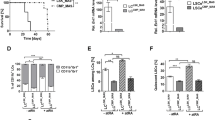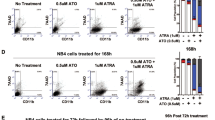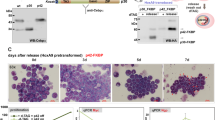Abstract
Acute promyelocytic leukemia (APL) is uniquely sensitive to treatment with all-trans retinoic acid (ATRA), which results in the expression of genes that induce the terminal granulocytic differentiation of the leukemic blasts. Here we report the identification of two ATRA responsive genes in APL cells, ID1 and ID2. These proteins act as antagonists of basic helix–loop–helix (bHLH) transcription factors. ATRA induced a rapid increase in ID1 and ID2, both in the APL cell line NB4 as well as in primary patient cells. In addition, a strong downregulation of E2A was observed. E2A acts as a general heterodimerization partner for many bHLH proteins that are involved in differentiation control in various tissues. The simultaneous upregulation of ID1 and ID2, and the downregulation of E2A suggest a role for bHLH proteins in the induction of differentiation of APL cells following ATRA treatment. To test the relevance of this upregulation, ID1 and ID2 were overexpressed in NB4 cells. Overexpression inhibited proliferation and induced a G0/G1 accumulation. These results indicate that ID1 and ID2 are important retinoic acid responsive genes in APL, and suggest that the inhibition of specific bHLH transcription factor complexes may play a role in the therapeutic effect of ATRA in APL.
This is a preview of subscription content, access via your institution
Access options
Subscribe to this journal
Receive 12 print issues and online access
$259.00 per year
only $21.58 per issue
Buy this article
- Purchase on Springer Link
- Instant access to full article PDF
Prices may be subject to local taxes which are calculated during checkout





Similar content being viewed by others
References
Melnick A, Licht JD . Deconstructing a disease: RARalpha, its fusion partners, and their roles in the pathogenesis of acute promyelocytic leukemia. Blood 1999; 93: 3167–3215.
Liu M, Iavarone A, Freedman LP . Transcriptional activation of the human p21(WAF1/CIP1) gene by retinoic acid receptor. Correlation with retinoid induction of U937 cell differentiation. J Biol Chem 1996; 271: 31723–31728.
Bocchia M, Xu Q, Wesley U, Xu Y, Korontsvit T, Loganzo F et al. Modulation of p53, WAF1/p21 and BCL-2 expression during retinoic acid-induced differentiation of NB4 promyelocytic cells. Leuk Res 1997; 21: 439–447.
Wang ZG, Delva L, Gaboli M, Rivi R, Giorgio M, Cordon-Cardo C et al. Role of PML in cell growth and the retinoic acid pathway. Science 1998; 279: 1547–1551.
Duprez E, Wagner K, Koch H, Tenen DG . C/EBPbeta: a major PML-RARA-responsive gene in retinoic acid-induced differentiation of APL cells. EMBO J 2003; 22: 5806–5816.
Yamanaka R, Kim GD, Radomska HS, Lekstrom-Himes J, Smith LT, Antonson P et al. CCAAT/enhancer binding protein epsilon is preferentially up-regulated during granulocytic differentiation and its functional versatility is determined by alternative use of promoters and differential splicing. Proc Natl Acad Sci USA 1997; 94: 6462–6467.
Tenen DG . Disruption of differentiation in human cancer: AML shows the way. Nat Rev Cancer 2003; 3: 89–101.
Massari ME, Murre C . Helix–loop–helix proteins: regulators of transcription in eucaryotic organisms. Mol Cell Biol 2000; 20: 429–440.
Norton JD . ID helix–loop–helix proteins in cell growth, differentiation and tumorigenesis. J Cell Sci 2000; 113 (Part 22): 3897–3905.
Hasskarl J, Duensing S, Manuel E, Munger K . The helix–loop–helix protein ID1 localizes to centrosomes and rapidly induces abnormal centrosome numbers. Oncogene 2004; 23: 1930–1938.
de Candia P, Solit DB, Giri D, Brogi E, Siegel PM, Olshen AB et al. Angiogenesis impairment in Id-deficient mice cooperates with an Hsp90 inhibitor to completely suppress HER2/neu-dependent breast tumors. Proc Natl Acad Sci USA 2003; 100: 12337–12342.
Fong S, Itahana Y, Sumida T, Singh J, Coppe JP, Liu Y et al. Id-1 as a molecular target in therapy for breast cancer cell invasion and metastasis. Proc Natl Acad Sci USA 2003; 100: 13543–13548.
Ruzinova MB, Schoer RA, Gerald W, Egan JE, Pandolfi PP, Rafii S et al. Effect of angiogenesis inhibition by Id loss and the contribution of bone-marrow-derived endothelial cells in spontaneous murine tumors. Cancer Cell 2003; 4: 277–289.
Sikder H, Huso DL, Zhang H, Wang B, Ryu B, Hwang ST et al. Disruption of Id1 reveals major differences in angiogenesis between transplanted and autochthonous tumors. Cancer Cell 2003; 4: 291–299.
Norton JD, Deed RW, Craggs G, Sablitzky F . Id helix–loop–helix proteins in cell growth and differentiation. Trends Cell Biol 1998; 8: 58–65.
Begley CG, Aplan PD, Davey MP, Nakahara K, Tchorz K, Kurtzberg J et al. Chromosomal translocation in a human leukemic stem-cell line disrupts the T-cell antigen receptor delta-chain diversity region and results in a previously unreported fusion transcript. Proc Natl Acad Sci USA 1989; 86: 2031–2035.
Mellentin JD, Smith SD, Cleary ML . lyl-1, a novel gene altered by chromosomal translocation in T cell leukemia, codes for a protein with a helix–loop–helix DNA binding motif. Cell 1989; 58: 77–83.
Mellentin JD, Murre C, Donlon TA, McCaw PS, Smith SD, Carroll AJ et al. The gene for enhancer binding proteins E12/E47 lies at the t(1;19) breakpoint in acute leukemias. Science 1989; 246: 379–382.
Dyck JA, Maul GG, Miller Jr WH, Chen JD, Kakizuka A, Evans RM . A novel macromolecular structure is a target of the promyelocyte-retinoic acid receptor oncoprotein. Cell 1994; 76: 333–343.
Koken MH, Puvion-Dutilleul F, Guillemin MC, Viron A, Linares-Cruz G, Stuurman N et al. The t(15;17) translocation alters a nuclear body in a retinoic acid-reversible fashion. EMBO J 1994; 13: 1073–1083.
Weis K, Rambaud S, Lavau C, Jansen J, Carvalho T, Carmo-Fonseca M et al. Retinoic acid regulates aberrant nuclear localization of PML-RAR alpha in acute promyelocytic leukemia cells. Cell 1994; 76: 345–356.
Lanotte M, Martin-Thouvenin V, Najman S, Balerini P, Valensi F, Berger R . NB4, a maturation inducible cell line with t(15;17) marker isolated from a human acute promyelocytic leukemia (M3). Blood 1991; 77: 1080–1086.
Glasser L, Fiederlein RL . Functional differentiation of normal human neutrophils. Blood 1987; 69: 937–944.
Brons PP, Haanen C, Boezeman JB, Muus P, Holdrinet RS, Pennings AH et al. Proliferation patterns in acute myeloid leukemia: leukemic clonogenic growth and in vivo cell cycle kinetics. Ann Hematol 1993; 66: 225–233.
Ruzinova MB, Benezra R . Id proteins in development, cell cycle and cancer. Trends Cell Biol 2003; 13: 410–418.
Yan W, Young AZ, Soares VC, Kelley R, Benezra R, Zhuang Y . High incidence of T-cell tumors in E2A-null mice and E2A/Id1 double-knockout mice. Mol Cell Biol 1997; 17: 7317–7327.
Yokota Y, Mansouri A, Mori S, Sugawara S, Adachi S, Nishikawa S et al. Development of peripheral lymphoid organs and natural killer cells depends on the helix–loop–helix inhibitor Id2. Nature 1999; 397: 702–706.
Zhuang Y, Soriano P, Weintraub H . The helix–loop–helix gene E2A is required for B cell formation. Cell 1994; 79: 875–884.
Morrow MA, Mayer EW, Perez CA, Adlam M, Siu G . Overexpression of the helix–loop–helix protein Id2 blocks T cell development at multiple stages. Mol Immunol 1999; 36: 491–503.
Peverali FA, Ramqvist T, Saffrich R, Pepperkok R, Barone MV, Philipson L . Regulation of G1 progression by E2A and Id helix–loop–helix proteins. EMBO J 1994; 13: 4291–4301.
Engel I, Murre C . E2A proteins enforce a proliferation checkpoint in developing thymocytes. EMBO J 2004; 23: 202–211.
Rutherford MN, LeBrun DP . Restricted expression of E2A protein in primary human tissues correlates with proliferation and differentiation. Am J Pathol 1998; 153: 165–173.
Zhao F, Vilardi A, Neely RJ, Choi JK . Promotion of cell cycle progression by basic helix–loop–helix E2A. Mol Cell Biol 2001; 21: 6346–6357.
Xin XQ, Nelson C, Collins L, Dorshkind K . Kinetics of E2A basic helix–loop–helix-protein expression during myelopoiesis and primary B cell differentiation. J Immunol 1993; 151: 5398–5407.
Voronova AF, Lee F . The E2A and tal-1 helix–loop–helix proteins associate in vivo and are modulated by Id proteins during interleukin 6-induced myeloid differentiation. Proc Natl Acad Sci USA 1994; 91: 5952–5956.
Ishiguro A, Spirin KS, Shiohara M, Tobler A, Gombart AF, Israel MA et al. Id2 expression increases with differentiation of human myeloid cells. Blood 1996; 87: 5225–5231.
Cooper CL, Newburger PE . Differential expression of Id genes in multipotent myeloid progenitor cells: Id-1 is induced by early- and late-acting cytokines while Id-2 is selectively induced by cytokines that drive terminal granulocytic differentiation. J Cell Biochem 1998; 71: 277–285.
Sikder HA, Devlin MK, Dunlap S, Ryu B, Alani RM . Id proteins in cell growth and tumorigenesis. Cancer Cell 2003; 3: 525–530.
Wadman IA, Osada H, Grutz GG, Agulnick AD, Westphal H, Forster A et al. The LIM-only protein Lmo2 is a bridging molecule assembling an erythroid, DNA-binding complex which includes the TAL1, E47, GATA-1 and Ldb1/NLI proteins. EMBO J 1997; 16: 3145–3157.
Lister JA, Baron MH . Induction of basic helix–loop–helix protein-containing complexes during erythroid differentiation. Gene Exp 1998; 7: 25–38.
Cammenga J, Mulloy JC, Berguido FJ, MacGrogan D, Viale A, Nimer SD . Induction of C/EBPalpha activity alters gene expression and differentiation of human CD34+ cells. Blood 2003; 101: 2206–2214.
Hui EK, Yung BY . Cell cycle phase-dependent effect of retinoic acid on the induction of granulocytic differentiation in HL-60 promyelocytic leukemia cells. Evidence for sphinganine potentiation of retinoic acid-induced differentiation. FEBS Lett 1993; 318: 193–199.
Acknowledgements
This work was supported by the Dutch Cancer Society.
Author information
Authors and Affiliations
Corresponding author
Rights and permissions
About this article
Cite this article
Nigten, J., Breems-de Ridder, M., Erpelinck-Verschueren, C. et al. ID1 and ID2 are retinoic acid responsive genes and induce a G0/G1 accumulation in acute promyelocytic leukemia cells. Leukemia 19, 799–805 (2005). https://doi.org/10.1038/sj.leu.2403699
Received:
Accepted:
Published:
Issue Date:
DOI: https://doi.org/10.1038/sj.leu.2403699
Keywords
This article is cited by
-
The CDK1/TFCP2L1/ID2 cascade offers a novel combination therapy strategy in a preclinical model of bladder cancer
Experimental & Molecular Medicine (2022)
-
Chromatin topology reorganization and transcription repression by PML-RARα in acute promyeloid leukemia
Genome Biology (2020)
-
Transcriptional repression of CDKN2D by PML/RARα contributes to the altered proliferation and differentiation block of acute promyelocytic leukemia cells
Cell Death & Disease (2014)
-
Coordinated regulation of the immunoproteasome subunits by PML/RARα and PU.1 in acute promyelocytic leukemia
Oncogene (2014)
-
ID2 and ID3 protein expression mirrors granulopoietic maturation and discriminates between acute leukemia subtypes
Histochemistry and Cell Biology (2014)



